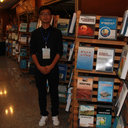A Layer-by-Layer Approach To Retain a Fluorescent Glucose Sensing Assay within the Cavity of a Hydrogel Membrane.
Ключевые слова
абстрактный
A continuous glucose monitoring device that resides fully in the subcutaneous tissue has the potential to greatly improve the management of diabetes. Toward this goal, we have developed a competitive binding glucose sensing assay based on fluorescently labeled PEGylated concanavalin-A (PEGylated-TRITC-ConA) and mannotetraose (APTS-MT). In the present work, we sought to contain this assay within the hollow central cavity of a cylindrical hydrogel membrane, permitting eventual subcutaneous implantation and optical probing through the skin. A "self-cleaning" hydrogel was utilized because of its ability to cyclically deswell/reswell in vivo, which is expected to reduce biofouling and therefore extend the sensor lifetime. Thus, we prepared a hollow, cylindrical hydrogel based on a thermoresponsive electrostatic double network design composed of N-isopropylacrylamide and 2-acrylamido-2-methylpropanesulfonic acid. Next, a layer-by-layer (LbL) coating was applied to the inner wall of the central cavity of the cylindrical membrane. It consisted of 5, 10, 15, 30, or 40 alternating bilayers of positively charged poly(diallyldimethylammonium chloride) and negatively charged poly(sodium 4-styrenesulfonate). With 30 bilayers, the leaching of the smaller-sized component of the assay (APTS-MT) from the membrane cavity was substantially reduced. Moreover, this LbL coating maintained glucose diffusion across the hydrogel membrane. In terms of sensor functionality, the assay housed in the hydrogel membrane cavity tracked changes in glucose concentration (0 to 600 mg/dL) with a mean absolute relative difference of ∼11%.


